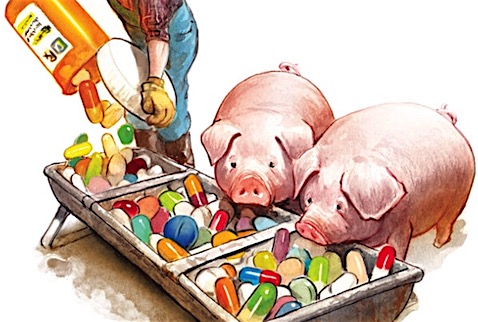Curb Antibiotic Use in Farm Animals
Curb Antibiotic Use in Farm Animals
New guidelines to curb the overuse of drugs in food animals are inadequate to deal with a growing crisis
In 1945 Alexander Fleming, the man who discovered penicillin, warned that overuse of his miracle drug could make bacteria immune to it. He was right—and not just about penicillin: the Centers for Disease Control and Prevention has estimated that antibiotic-resistant bacteria infect more than two million people a year, at least 23,000 of whom die. A significant part of that overuse, the cdc says, involves feeding the drugs to the animals we eat. Farmers do this not to cure or prevent disease but simply to make livestock grow bigger and faster.
In 2013 the Food and Drug Administration finally stepped in, asking drug companies to stop selling antibiotics for the purpose of promoting the growth of animals by December 2016. The agency still allows the use of these drugs for “disease prevention,” however—that is, to fight off infections animals have not yet gotten. In principle, it might sound reasonable. In practice, this loophole may be big enough to allow farmers to continue with what they have been doing all along, raising concerns that the fda's plan will not amount to much.
To make things worse, the fda resisted developing a meaningful plan to evaluate the effect of its action. Instead it intends simply to rely on sales data from drug companies to see whether its (nonbinding) guidelines are actually working. These data are far from ideal for this purpose; even the agency acknowledges that sales are not a reliable way to gauge how antibiotics are really being used.
The data offer no sense of whether the plan is working. The agency's recently released antibiotic sales figures for 2014 show a small increase over 2013, which is consistent with trends in previous years. That result is not surprising, given that the drug companies were not asked to comply fully with the new guidelines until the end of this year. We will have more meaningful information when the fda releases the 2016 data sometime late in 2017.
Unfortunately, we can't wait that long. Despite acknowledging that misuse in animals is a big part of the problem, the cdc can't figure out exactly how big it is. We are also getting disconcerting signals from around the world, including recent news of the emergence and spread of the mcr-1 gene, which helps bacteria resist even some of our last-resort antibiotics. An infection with bacteria that sport this gene could be fatal, even in the best health care settings. The alarm was sounded late last year, when this gene was discovered in pigs and humans in China, and since then, it has been found in several other countries. It has yet to show up in the U.S., which is reassuring in the short term, but it may be only a matter of time before it finds its way here.
How worried should we be? More than we are, that's for sure, at least until we change the way antibiotics are used. Sadly, not enough is being done. The biggest battles are being fought over proposals for unfunded, voluntary agency initiatives to collect better antibiotic usage data. Such information could be helpful in determining the full extent to which antibiotic misuse is contributing to untreatable bacterial infections in people. No plan has been put on the table that can change the way the drugs are actually used.
The funding situation is not likely to get much better in the near term. In spite of the $375 million proposed in the current congressional budget to combat outbreaks of antibiotic-resistant bacteria, only $8.7 million (or a little more than 2 percent) is earmarked for the fda to address antibiotic resistance in the first place. The U.S. Department of Agriculture did not receive a line-item allocation of funds for the same purpose.
People born in the past 70 years are fortunate enough to live in a time when major medical and public health advances, including antibiotics, have allowed us to live long enough to die from chronic diseases instead of infectious ones. The misuse of antibiotics in animal agriculture threatens to hurtle us into a postantibiotic world, where even the most routine infections may become deadly. We must take meaningful action—and fast.
Source: http://www.scientificamerican.com/article/curb-antibiotic-use-in-farm-animals/
